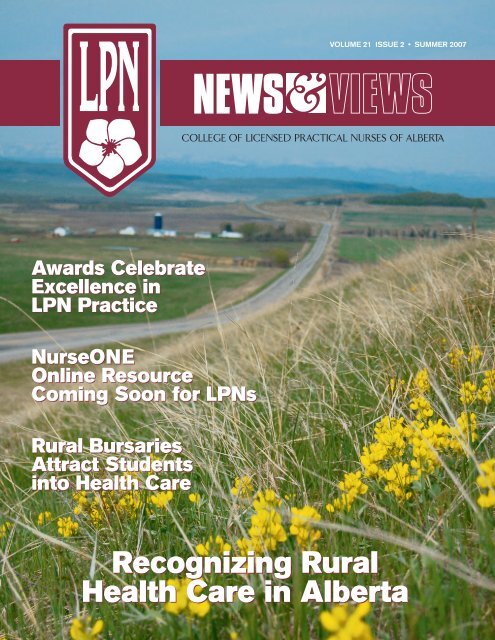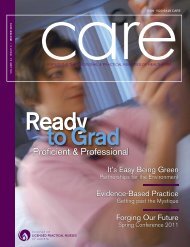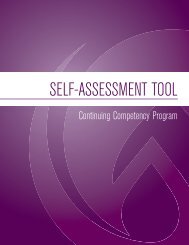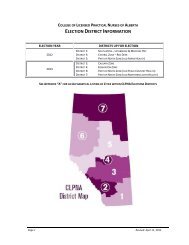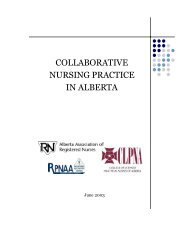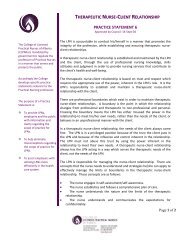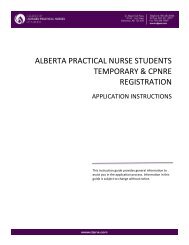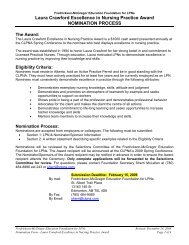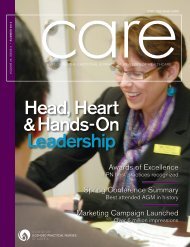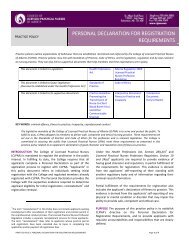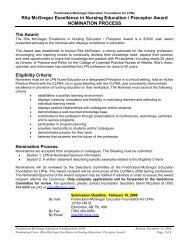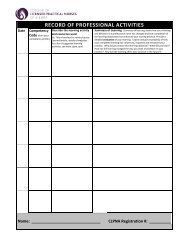Download PDF - College of Licensed Practical Nurses of Alberta
Download PDF - College of Licensed Practical Nurses of Alberta
Download PDF - College of Licensed Practical Nurses of Alberta
- No tags were found...
Create successful ePaper yourself
Turn your PDF publications into a flip-book with our unique Google optimized e-Paper software.
VOLUME 21 ISSUE 2 • SUMMER 2007NEWS&VIEWSCOLLEGE OF LICENSED PRACTICAL NURSES OF ALBERTAAwards CelebrateExcellence inLPN PracticeNurseONEOnline ResourceComing Soon for LPNsRural BursariesAttract Studentsinto Health CareRecognizing RuralHealth Care in <strong>Alberta</strong>
2Volume 21 Issue 2Summer 2007News and Views is a quarterly publicationand is the <strong>of</strong>ficial publication <strong>of</strong> the <strong>College</strong><strong>of</strong> <strong>Licensed</strong> <strong>Practical</strong> <strong>Nurses</strong> <strong>of</strong> <strong>Alberta</strong>.Reprint/copy <strong>of</strong> any article requires priorconsent <strong>of</strong> the Editor <strong>of</strong> News & Views.Editor - T. BatemanSigned articles represent the views <strong>of</strong> theauthor and not necessarily those <strong>of</strong> theCLPNA.The editor has final discretion regarding theacceptance <strong>of</strong> notices, courses or articlesand the right to edit any material. Thisdoes not indicate CLPNA endorsement.SubscriptionAutomatic for CLPNA members.$21.00 for non-members.CLPNA CouncilPresidentRuth WoldDistrict 1 (RHA Regions 1, 2)Glen HerbstDistrict 2 (RHA Region 3)Hugh PedersenDistrict 3 (RHA Regions 4, 5)Bonnie StickneyDistrict 4 (RHA Region 6)Marilyn McGreerDistrict 5 (RHA Region 7)Jenette LappenbushDistrict 6 (RHA Region 8)Denise Simard-ZawackiDistrict 7 (RHA Region 9)Vice PresidentKathy ReidPublic MembersPeter Bidlock / Ted LangfordRobert MitchellTo contact Council members pleasecall the CLPNA <strong>of</strong>fice and yourmessage will be forwarded to them.StaffLinda StangerExecutive Director / Registrarlinda@clpna.comTamara RichterDirector <strong>of</strong> Operationstamara@clpna.comTeresa BatemanDirector <strong>of</strong> Pr<strong>of</strong>essional Practiceteresa@clpna.comSharlene StandingDirector <strong>of</strong> Regulatory Servicessharlene@clpna.comCLPNARegular Office HoursMonday to Friday8:30am to 4:30pmClosed in recognition <strong>of</strong>statutory holidays:Canada DayJuly 2, 2007Civic HolidayAugust 6, 2007Labor DaySeptember 3, 2007Thanksgiving DayOctober 8, 2007COVER PHOTO:<strong>Alberta</strong> foothills near Okotoks, May 2007 - Chris FieldsCheck out theNEW CLPNA Websitewww.clpna.com• Regulations and Standards• Practice Statements• CLPNA Publications• Education Fundingand more…Our Vision<strong>Licensed</strong> <strong>Practical</strong> <strong>Nurses</strong> are a nurse <strong>of</strong> choice, trusted partnersand valued pr<strong>of</strong>essionals in the health care system.The CLPNA embraces change that serves the best interests <strong>of</strong> the public,the pr<strong>of</strong>ession, and a quality health care system.By 2010 the CLPNA expects to see:• Employers seeking LPNs as a nurse <strong>of</strong> choice consistently utilizing them to fullscope <strong>of</strong> practice• A dramatic shift in the nursing skill mix with LPNs practicing in a broader range<strong>of</strong> health care services within a diverse system• A pr<strong>of</strong>ound increase in the use <strong>of</strong> LPNs with 10,000 registrants meeting thehealth care needs <strong>of</strong> <strong>Alberta</strong>ns• LPNs actively involved in planning, decision making, and leadership activitieswithin the workplace, the pr<strong>of</strong>ession, and the health care system• LPNs as an integral part <strong>of</strong> primary health care• An LPN diploma as the education credential required for entry to practice• New and challenging post graduate education opportunities for LPNs toexpand their knowledge and abilities• National structures and standards that achieve greater consistency in therole and responsibilities <strong>of</strong> <strong>Practical</strong> <strong>Nurses</strong> across Canada.Our MissionTo regulate and lead the pr<strong>of</strong>ession in a manner that protects andserves the public through excellence in <strong>Practical</strong> Nursing.Our ValuesPROFESSIONALISM EMPOWERMENT PRO-ACTIVITY PARTNERSHIPS
3ALBERTAHEALTH AND WELLNESSMessage from Honourable Dave Hancock, Q.C.Minister <strong>of</strong> Health and WellnessOn behalf <strong>of</strong> the Government <strong>of</strong> <strong>Alberta</strong>, I would like to sincerely thank all <strong>Licensed</strong><strong>Practical</strong> <strong>Nurses</strong> in the province for continued dedication during this 60th anniversary.In my time as Minister <strong>of</strong> <strong>Alberta</strong> Health and Wellness, I have been continuallyimpressed with the level <strong>of</strong> commitment and passion that nurses bring to their pr<strong>of</strong>essionand the positive difference they make in the lives <strong>of</strong> <strong>Alberta</strong>ns each and every day.The future <strong>of</strong> our province depends on our health and well-being as individuals, familiesand communities. Our health determines the quality <strong>of</strong> life we enjoy, our capacity topursue what we want in life and our ability to care for our families and build andsustain vibrant communities.<strong>Licensed</strong> <strong>Practical</strong> <strong>Nurses</strong> play a vital role in enhancing the wellness<strong>of</strong> <strong>Alberta</strong>ns, and helping <strong>Alberta</strong>ns realize a healthy future.Again, congratulations on this milestone occasion and all the bestfor the next 60 years <strong>of</strong> nursing in <strong>Alberta</strong>.Dave Hancock, Q.C.Minister <strong>of</strong> Health and Wellness
4From thePresident’sPenPRESIDENTIAL ADDRESSSUMMARY2007 CLPNA SPRING CONFERENCEThis is an exciting year forour Pr<strong>of</strong>ession as we celebrate60 years – 60 years<strong>of</strong> providing nursing care to<strong>Alberta</strong>ns. We <strong>of</strong>ten hear that“nurses are at the heart <strong>of</strong>healthcare” and indeed <strong>Licensed</strong><strong>Practical</strong> <strong>Nurses</strong> are at the heart<strong>of</strong> healthcare and have been for60 years! By now each one <strong>of</strong>you will have received your LPN60th Anniversary Pin. I encourageyou to wear it with pride;wear it with pride for the contributions you make on a daily basisin the delivery <strong>of</strong> quality health services and for the proud legacy<strong>of</strong> our Pr<strong>of</strong>ession.History plays a significant role in an organization such as ours.It is that history that defines us and provides the solid frameworkon which we continue to build today. It was vision, dedication,and commitment that brought the LPN Pr<strong>of</strong>ession forward towhere we are today in 2007. It is that same vision, dedication,and commitment that will ensure that LPNs move forward withinthe dynamic and evolving health care environment recognizedfor the value <strong>of</strong> their education, knowledge, and abilities in providingquality care to <strong>Alberta</strong>ns. It is as we continue to build onour core values we will ensure ongoing success <strong>of</strong> our Pr<strong>of</strong>ession.Change is no stranger to the pr<strong>of</strong>ession <strong>of</strong> nursing – there havebeen dramatic changes in the past 60 years. Imagine for amoment a conversation between a graduate <strong>of</strong> 1947 and a graduate<strong>of</strong> 2007 – what an intriguing conversation that would be.I am sure the focus <strong>of</strong> the conversation would be on change.Imagine the difference in the way we do things in health caretoday as compared to 1947. We have much to learn from historybut one thing remains unchanged and that is our core value <strong>of</strong>serving the public through excellence in practical nursing. As<strong>Nurses</strong>, we have all been impacted by change and it is at a rapidpace that we are facing change. We are working in diverse workenvironments and we are in the midst <strong>of</strong> healthcare workershortages. We are experiencing ongoing change within our ownPr<strong>of</strong>ession and at our worksites. There is a quote that goes likethis: “Many <strong>of</strong> us don’t like change but change doesn’t muchcare.” Not only must we embrace change but we must also helpshape and lead change.In June, your Council will be going through an extensive strategicplanning process; looking at our current strategic plan and determiningthose areas that we need to further focus on and develop.A strategic plan <strong>of</strong> an organization such as ours is that component<strong>of</strong> looking to the future; the where to from here. It is now2007 and are we headed in the right direction; are we on the rightpath? It is the strategic plan which is critical to defining the futuredirection <strong>of</strong> the <strong>College</strong> and the Pr<strong>of</strong>ession. A component <strong>of</strong>successful strategic planning is taking into consideration trends,opportunities and challenges; knowing what is truly happeningin the healthcare environment and with you, our membership.I want to share with you some <strong>of</strong> the current aspects which fallunder the Vision component <strong>of</strong> our strategic plan. Often as membership,if we are not involved in <strong>College</strong> activities such as volunteeringon one <strong>of</strong> the many <strong>College</strong> Committees or representing adistrict at the Council table, it is difficult to see the big picture <strong>of</strong>what our pr<strong>of</strong>essional organization does on behalf <strong>of</strong> each one <strong>of</strong>us as members <strong>of</strong> the CLPNA. Let me share with you some keyaspects <strong>of</strong> what the CLPNA is doing on your behalf.During our last major strategic planning process, the Councilidentified visionary areas <strong>of</strong> focus with the target year <strong>of</strong> 2010.The first area <strong>of</strong> focus for the CLPNA is that by 2010 employersare seeking LPNs as a nurse <strong>of</strong> choice and consistently utilizingthem to full scope <strong>of</strong> practice. We have seen forward movementin this area. I know in speaking with some <strong>of</strong> you that being utilizedto full scope <strong>of</strong> practice is not yet happening in your place <strong>of</strong>employment. But I do want to encourage you that it is happeningaround the province. New graduates expect to work to full scope<strong>of</strong> practice and to be able to utilize all they have been taught.Under-utilization <strong>of</strong> <strong>Licensed</strong> <strong>Practical</strong> <strong>Nurses</strong> across <strong>Alberta</strong> hasbeen a serious concern for the CLPNA for years and is an areathat we will continue to actively pursue with employers andHealth Regions in promoting LPNs to full scope. We are relyingon the data from the recent LPN Survey to provide us withvaluable information to take forward to your employers and tostakeholders within <strong>Alberta</strong>. At a conference I recently attended,one <strong>of</strong> the speakers made a comment regarding the nursingshortage, “We will not know if we have a true picture <strong>of</strong> thenursing shortage until everyone is working to full scope <strong>of</strong>practice.” Such insight in just a few words.Another area <strong>of</strong> focus for the <strong>College</strong> is that, by the year 2010,the CLPNA expects to see a pr<strong>of</strong>ound increase in the use <strong>of</strong>LPNs with 10,000 registrants meeting the health care needs <strong>of</strong><strong>Alberta</strong>ns. Well, it is not yet 2010 and we are not yet at 10,000registrants, but our numbers are on the increase with current registrationnumbers at 6794. We know that we have to increase ournumbers to meet the demand. As well, like others, LPNs plan toretire one day. Not only do we need to ensure that we have LPNsto replace our retiring LPNs, but as our Pr<strong>of</strong>ession moves forwardand as LPNs are recognized for their knowledge, education,and abilities and valued for their expertise, I believe there will bea greater demand for LPNs. We need to further develop strategiescontinued next page
5for ensuring we are educating adequate numbers <strong>of</strong> LPNs.A third area <strong>of</strong> focus is that LPNs are actively involved inplanning, decision making, and leadership activities within theworkplace, the pr<strong>of</strong>ession, and the health care system. Morethan ever, LPNs are assuming roles <strong>of</strong> leadership. We haveLPNs in team leading roles; in management roles; and in educationleadership roles. At the recent CLPNA Spring Conferencewe were privileged to hear from two <strong>of</strong> our own LPNs, SabinaRobin who is a leader as a Patient Safety Champion for theWorld Health Organization and from Sgt. Larry Leduc, an LPNon the front lines with the Canadian Forces. Both <strong>of</strong> these individualsdemonstrate true leadership. Unless you have opportunityto hear about them, you don’t know that these things arehappening within our Pr<strong>of</strong>ession!All <strong>of</strong> us have the opportunity to be leaders within ourPr<strong>of</strong>essional Practice. I encourage you to be a leader. Share yourknowledge and expertise with your colleagues; take the time tomentor a nursing student or new graduate; communicate yourrole and scope <strong>of</strong> practice to colleagues who may be unfamiliarwith your scope <strong>of</strong> practice and take the opportunity to demonstrateyour commitment to excellence by getting involved withyour Pr<strong>of</strong>essional Organization.The CLPNA needs you! We need LPNs who are willing to takeon a leadership role on behalf <strong>of</strong> all <strong>of</strong> us as <strong>Licensed</strong> <strong>Practical</strong><strong>Nurses</strong>. There are opportunities for you to take a leadership roleon Council and as well, on a variety <strong>of</strong> CLPNA Committees.Being involved with our Pr<strong>of</strong>essional Organization has openedmy eyes to the depth <strong>of</strong> our Pr<strong>of</strong>ession and the bigger picture <strong>of</strong>nursing and healthcare, but more importantly has allowed methe opportunity to impact change for the betterment <strong>of</strong> ourPr<strong>of</strong>ession. Remember that leadership is the simple act <strong>of</strong> makinga difference. I encourage you to become an effective leader.The last area <strong>of</strong> focus for the CLPNA that I will highlight isthat, by 2010, there are new and challenging post-graduate educationopportunities for LPNs to expand their knowledge andabilities. This area <strong>of</strong> focus is well in progress. There are nowmany post-basic education courses developed for LPNs: leadership,mental health, and gerontology, just to name a few. Theaccessibility to NurseONE will provide each registrant theopportunity to access current information and allows LPNs t<strong>of</strong>urther their education on an individual basis. Through thecommitment <strong>of</strong> our government to support <strong>Licensed</strong> <strong>Practical</strong><strong>Nurses</strong>, there are now funds to access for further educationthrough the Fredrickson-McGregor Education Foundation forLPNs.I am confident that Council’s established goals and outcomeswill continue to prepare and move LPNs forward within adynamic and evolving health care environment. We must beengaged in a continual pursuit <strong>of</strong> excellence both in our individualpractice and as an organization. I am committed, along withCouncil and our Executive Director, to build on our strategicplan in advancing our Pr<strong>of</strong>ession and in enhancing support toyou, our membership.Ruth Wold, President CLPNAGreetings from theExecutive DirectorThe past year has beensignificant year <strong>of</strong> transitionfor the CLPNAas the senior team <strong>of</strong> PatFredrickson and RitaMcGregor retired from theorganization in June 2006.Through the commitment <strong>of</strong>our Council to successionplanning, and the dedication<strong>of</strong> staff to the process, thetransfer <strong>of</strong> responsibility tothe new team has been aseamless and smooth transition.Our work continues t<strong>of</strong>ocus on the key areas <strong>of</strong> regulation,education, advocacy,and leadership as identified inthe strategic plan <strong>of</strong> the<strong>College</strong>.The role and the demand for the LPN are expanding and thepr<strong>of</strong>ession is growing. Membership in the <strong>College</strong> has increasedby 5.1% over the previous year as a result <strong>of</strong> increased educationseats, and in-migration. The numbers <strong>of</strong> LPNs transferring fromother Canadian jurisdictions is up 65% over 2005, and is projectedto grow at a similar rate in 2007. Our LPN workforce, atan average age <strong>of</strong> 43, is among the youngest in the country.A Diploma was approved by government as the entry-to-practicecredential for the pr<strong>of</strong>ession. The education program has beenexpanded to two years and provides greater depth and breadth<strong>of</strong> nursing content, exposure to liberal arts courses, andenhanced development <strong>of</strong> critical thinking skills allowing newgraduates to meet the changing healthcare needs <strong>of</strong> <strong>Alberta</strong>nstoday and in the future. Graduates <strong>of</strong> the Diploma program arenow entering the workforce.Columbia <strong>College</strong>, Calgary, became the first private college tobe approved as a provider <strong>of</strong> the practical nurse program andwe are pleased to add this <strong>College</strong> to our list <strong>of</strong> partners ineducation. Their first intake <strong>of</strong> students occurred this spring.We are grateful for the endowment fund <strong>of</strong> $3 million plus atransition fund <strong>of</strong> $300,000 to support post-basic learning needs<strong>of</strong> LPNs that was received from <strong>Alberta</strong> Health and Wellness.The Fredrickson-McGregor Education Foundation for <strong>Licensed</strong><strong>Practical</strong> <strong>Nurses</strong> has been established, the processes developed,and funding is being distributed. Details are available in theFredrickson-McGregor Foundation report within this newsletter.CLPNA continues to be leaders and active participants inprovincial and national initiatives; on steering committees relatedto education, practice and research, attending meetings and conferencesto represent our pr<strong>of</strong>ession to LPNs, other pr<strong>of</strong>essions,employers, educators, government and the public. We continueto build on existing relationships and cultivate new partnershipsthat are important to the success <strong>of</strong> the organization and thepr<strong>of</strong>ession.continued next page
6Greetings…continued from page 5Thank you to everyone who participatedin the Newsletter survey,the Utilization survey, andStandards/Code <strong>of</strong> Ethics surveyconducted in the past six months.Your input is critical and continuesto be used in shaping futuredirection <strong>of</strong> the <strong>College</strong>.CLPNA realized a 42% responserate to the Utilization survey.Over 1500 LPNs included narrativecomments which providevaluable insights regarding yourwork life and day to day challenges.Highlights <strong>of</strong> theUtilization survey were presentedat Conference. Initial findingsindicate there has been significantimprovement in the utilization <strong>of</strong>knowledge skill and ability <strong>of</strong> theLPN in <strong>Alberta</strong>. In 2002, 33% <strong>of</strong>LPNs believed they were beingfully utilized compared to 51% in2007. The challenge: almost half<strong>of</strong> the LPNs in <strong>Alberta</strong> reportthat they are underutilized. Fulldetails from the survey will bepresented when data analysis iscomplete.Work continues on revisions tothe Standards <strong>of</strong> Practice andCode <strong>of</strong> Ethics. The input youhave provided will contribute tothe overall quality <strong>of</strong> the finaldocument.I have provided a few <strong>of</strong> the highlights<strong>of</strong> our past year. The completeAnnual Report for 2006 isavailable at www.clpna.com.This first year as ExecutiveDirector has been challengingand rewarding. The level <strong>of</strong> commitmentshared by Council, staff,committees and partners, to ourmandate <strong>of</strong> public protectionthough excellence in practicalnursing is evident in all they do.The Executive team looksforward with enthusiasm aswe pursue the goals and vision<strong>of</strong> the CLPNA over the comingyear.Linda StangerExecutive Director/Registrar,CLPNACOUNCIL HIGHLIGHTSMeeting Dates: March 1-2, 2007 and Conference calls February 26 and April 4, 2007.• CLPNA has reviewed and responded to <strong>Alberta</strong> Health and Wellness regardingrecommended changes to the Health Pr<strong>of</strong>essions Act.• As <strong>of</strong> March 1, 2007, CLPNA reported to have 6455 registrants. All 2007 registrants havecurrent learning plans, the majority <strong>of</strong> which are based on the competency pr<strong>of</strong>ile.• Membership Survey completed March 1 with a 42% response rate. A summary <strong>of</strong> surveyresults will be shared at Spring Conference and more broadly with LPNs, government,employers and other stakeholders when final results are available.• CLPNA along with the <strong>College</strong> and Association <strong>of</strong> Registered <strong>Nurses</strong> <strong>of</strong> <strong>Alberta</strong>(CARNA), the <strong>College</strong> <strong>of</strong> Registered Psychiatric <strong>Nurses</strong> <strong>of</strong> <strong>Alberta</strong> (CRPNA) and the <strong>College</strong><strong>of</strong> Physicians and Surgeons <strong>of</strong> <strong>Alberta</strong> (CPSA), submitted a letter to Children’s Services insupport <strong>of</strong> a request for funding by Doctors Opposed to Violence Everywhere (DOVE) toeducate pr<strong>of</strong>essionals on family violence.• BowValley <strong>College</strong> has created a fast-track program that shortens the time required tocomplete the basic practical nurse program by approximately three months. Students mustapply and selection is based on academic performance. The first group from this programgraduated in December 2006.• <strong>Alberta</strong> Health and Wellness provided an information session for Council regarding <strong>Alberta</strong>Provider Directory (APD). CLPNA is one <strong>of</strong> the first five <strong>College</strong>s to fully participate.• NurseONE was introduced to Council as a web-based information system which has beendeveloped by nurses for nurses and has 24-hour accessibility. CLPNA is entering a contractwith Canadian <strong>Nurses</strong> Association (developer) to provide this service to LPNs on a one-yeartrial. Usage will be monitored as part <strong>of</strong> the ongoing evaluation.• <strong>Nurses</strong> Week Recognition - a 60th Anniversary commemorative pin will be distributed toeach LPN in <strong>Alberta</strong> with a congratulatory letter. The <strong>College</strong> added an on-line order formfor members to receive Nursing Week promotional items.• Council endorsed a letter to United <strong>Nurses</strong> <strong>of</strong> <strong>Alberta</strong> (UNA) in response to the UNA adcampaign.• Elections are open for several Districts and Vice President.- Calgary Health Region – Hugh Pedersen will have completed his first term.- Capital Health Region – Marilyn McGreer will have completed her first term.- Peace Country Health Region – Kathy Reid, Vice President will have completed two terms.- Northern Lights Health Region – Denise Simard-Zawacki will have completed two terms.The CLPNA Council approved:• Auditor’s Presentation - Approval <strong>of</strong> financial statements and audit report for year endingDecember 31, 2006.• Penny Kwasny - Appointed as the ESAC Employer Representative to ESAC toDecember 31, 2008.• Glen Herbst - Appointed to complete District 1 term, commencing March 2007 to June 2008.• Lethbridge Community <strong>College</strong> – Council approved Lethbridge Community <strong>College</strong> PNDiploma program for implementation as per the recommendation from Education StandardsAdvisory Committee (ESAC).• ESAC Standards <strong>of</strong> Practice – Council approved the revised Standards <strong>of</strong> Practice.• ESAC Approval Fees – Council approved recommended fee structure associated withprogram reviews.Next Meeting Date: June 28-29, 2007
8THE CANADIAN NURSES PORTALWhat is NurseONE?NurseONE is a personalized interactive web-based resourceproviding nurses in Canada – this country’s health careknowledge workers – with access to current and reliableinformation to support their nursing practice, manage theircareers, and connect with colleagues and health-careexperts.What can NurseONE <strong>of</strong>fer me?You can access up-to-date, accurate information on a widerange <strong>of</strong> topics fully vetted and reviewed by the Canadian<strong>Nurses</strong> Association (C.N.A.) and its review committee.Information from a trusted source – NurseONE is youronline colleague.Pr<strong>of</strong>essional Practice: you can enrich your knowledgethrough evidence-based information, clinical references,disease-specific information, nursing policy statements,and much more.Online Libraries: you can immediately access theCochrane Collection, e-CPS, e-Therapeutics and STAT!Ref Electronic Medical Library.Careers: you can send career questions to health-carecareer management experts, develop your portfolio or postyour resume on-line.As well, you have My Account, a personalized section <strong>of</strong>the site visible to you at all times while you are working inNurseONE and where you can save documents, webaddresses and other important items.And this is just the beginning; NurseONE also <strong>of</strong>fers aself-assessment tool to assist nurses in managing theircontinuing competency requirements, emergencypreparedness resources and will soon <strong>of</strong>fer onlinediscussion forums.How and why was NurseONE created?Delivering health care in Canada’s diverse communities – fromlarge urban centres to small northern inlets – is a challenge. Butit is a challenge that the First Nations and Inuit Health Branch <strong>of</strong>Health Canada knew could be overcome with technology. FNIHBpartnered with the C.N.A. and provided three years <strong>of</strong> fundingto create NurseONE, a unique personalized and interactiveWeb-based resource to support Canada’s nurses.To ensure NurseONE’s relevance to you, we tested it with nursesthroughout its development. The results have influenced theportal’s navigation and will continue to impact the informationthat is developed for the site.How can I access NurseONE?NurseONE recently became available for LPNs and CLPNA willbe piloting it in early June with a selected group. Completeinformation on how to log onto the system will be in theSeptember newsletter.Important Informationto CLPNA Members:The portal is web-based and therefore requires you to have avalid e-mail address. If you want to be included in any <strong>of</strong> thee-mails regarding NurseONE, you must provide us with anup-to-date e-mail address. You can send an e-mail to TamaraRichter at tamara@clpna.com. If you have received e-mails fromTamara in the past few months, then your e-mail address doesnot need to be updated.
9Rural Bursaries AttractStudents into Health CareBursary Programs ExpandStudents from across <strong>Alberta</strong> can applyfor a bursary. In exchange, they commit to living andworking in northern <strong>Alberta</strong> after graduation. Examples <strong>of</strong>the types <strong>of</strong> programs students can receive bursaries for includehealth care, business, technical programs and education.The Northern <strong>Alberta</strong> Development Council’s (NADC) bursary programs are expanding.The NADC Bursary has increased from $3,000 to $3,500 for this year, and anadditional 25 students will be able to receive the bursary, bringing the total to 150.“In today’s tight labour market, the NADC Bursary plays an important role insecuring a commitment from students to return to the north,” said Helen Henderson,Chair <strong>of</strong> the NADC Bursary Selection Committee. “We are pleased that we can <strong>of</strong>fermore funding to more students.”“The government recognizes <strong>Alberta</strong>’s labour force needs are unique, especiallyin northern <strong>Alberta</strong>,” added Iris Evans, Minister <strong>of</strong> Employment, Immigrationand Industry. “That is why we are pleased to be able to provide additional fundsto the Council for their bursaries. The bursaries will have a positive impact forthe workforce in the north.”“There are so many opportunities for work in northern <strong>Alberta</strong>”, said AudreyDeWit, NADC’s Team Leader for the bursary programs. “We’ve seen anincrease in students successfully fulfilling their return service.”Health Care Practicum FundingThe NADC has a new program to encourage students <strong>of</strong> health care programs toconsider a northern <strong>Alberta</strong> practicum location that <strong>of</strong>fers great experiences andlots <strong>of</strong> variety.The Health Care Practicum Funding Program is <strong>of</strong>fered jointly by northernhealth regions and the Northern <strong>Alberta</strong> Development Council. Each healthregion has designated specific locations and practicum positions that can befunded. This funding can help students with the costs <strong>of</strong> travel to and from acommunity, and with accommodation costs while they are there. Note that onlypracticum placements in health region facilities and programs are eligible.Funding approval is not automatic. Funds are limited and applications may beprioritized based on regional demand. Students need to contact their college oruniversity placement coordinator to find out which placements are designated toreceive funding.More information on these and other funding programs is available on theNADC’s website at www.nadc.gov.ab.ca. Interested students can also call780-624-6545 (toll-free by first dialing 310-0000).The Canadian Council for <strong>Practical</strong>Nurse Regulators (CCPNR)CCPNR is a federation <strong>of</strong> provincialand territorial members identified inlegislation as responsible for the safety<strong>of</strong> the public through the regulation <strong>of</strong><strong>Licensed</strong> <strong>Practical</strong> <strong>Nurses</strong>. The primaryfunctions <strong>of</strong> the CCPNR include;• Collaborating among provincial/territorial regulatory organizationsto maintain and enhancepr<strong>of</strong>essional relationships.• Supporting provincial/territorialorganizations with regard todecision-making, resourceallocation, and managementissues, and individual provincial/territorial regulatory laws andresources.• Supporting processes that allowfor accountability and responsibilityfor decisions and which recognizethe individuality <strong>of</strong> the jurisdiction.• Promoting excellence in practicalnursing regulation by demonstratingleadership, best practice,innovation and pr<strong>of</strong>essionaldevelopment.Visit the CCPNR website for moreinformation at www.ccpnr.caCLPNA is a member <strong>of</strong> CCPNR andparticipates on the executive committee.
10Improving <strong>Alberta</strong>ns’ quality <strong>of</strong> lifeFebruary 23, 2007News releaseHealth regions receive $8 million to improve immunization deliveryEdmonton… The <strong>Alberta</strong> government will distribute $8 million to the province’s nine health regions over two years in an effort to increaseimmunization rates.As part <strong>of</strong> a new Innovation in Immunization Fund, health regions will be expected to submit an implementation plan and agree to submit twoannual reports to document progress. Examples <strong>of</strong> strategies the regions may implement to enhance access to immunization services includeextended clinic hours or client outreach programs like mobile clinics.“This funding reflects our commitment to prevention and wellness,” said <strong>Alberta</strong> Health and Wellness Minister Dave Hancock. “While <strong>Alberta</strong>has one <strong>of</strong> the most comprehensive publicly-funded immunization programs in Canada, we know that some <strong>Alberta</strong>ns are still at risk <strong>of</strong> serious,and sometimes fatal, vaccine-preventable diseases. We also know that outbreaks <strong>of</strong> preventable diseases still occur in our province. Thisinitiative will help health regions to improve immunization rates in <strong>Alberta</strong>.”The new fund is one way <strong>of</strong> increasing accessibility to immunization services and is part <strong>of</strong> <strong>Alberta</strong>’s first-ever immunization strategy. Thestrategy is a 10-year plan to minimize the risk <strong>of</strong> vaccine-preventable diseases by increasing immunization rates.Seven strategic directions outlined in the strategy will be implemented to increase immunization rates: enhance accessibility; improve enablingtechnology; strengthen parental education and counselling; strengthen partnerships; strengthen provider training and education; strengthenpublic education and awareness; and strengthen research and evaluation.The <strong>Alberta</strong> Immunization Strategy helps promote wellness and disease prevention and is one <strong>of</strong> the actions under Premier Ed Stelmach’splan to improve <strong>Alberta</strong>ns’ quality <strong>of</strong> life.<strong>Alberta</strong> Immunization Strategy quick facts• Implementation plans for the Innovation in Immunization Fund (IIF) will be submitted by health regions to <strong>Alberta</strong> Health and Wellness. Theplans must address immunization barriers that are unique to each health region and contain innovative, evidence-based ideas to overcomethose barriers.• Regional Health Authorities will receive IIF money before the end <strong>of</strong> March for use over the next two years.• Funding was determined through a population-based formula with consideration also given to the number <strong>of</strong> children, seniors, lowsocio-economic groups and <strong>Alberta</strong>ns living about one hour or more from a hospital in each region. The funding allocation is as follows:- Chinook Health Region - $482,000- Palliser Health Region - $250,000- Calgary Health Region - $2.5 million- David Thompson Regional Health Authority - $819,000- East Central Health - $282,000- Capital Health - $2.4 million- Aspen Regional Health Authority - $573,000- Peace Country Health - $409,000- Northern Lights Health Region - $272,000• <strong>Alberta</strong> has one <strong>of</strong> the most comprehensive publicly-funded immunization programs in Canada. <strong>Alberta</strong>’s routine immunization schedulebegins at two months <strong>of</strong> age. It is important for parents to start their child with a first appointment at two months <strong>of</strong> age and make it apriority to schedule the next appointment when it is due. By two years <strong>of</strong> age, children should have received four doses <strong>of</strong> DTaP-IPV-Hib,which protects against diphtheria, tetanus, pertussis (whooping cough), polio and Haemophilus influenza type B; and one dose <strong>of</strong> MMR,which protects against measles, mumps and rubella.• Despite <strong>Alberta</strong>’s immunization success, immunization rates are still below target. Since 1996, immunization rates for one and two-year-oldchildren have been between five and 20 per cent below target for some immunizations.• Outbreaks <strong>of</strong> serious vaccine-preventable diseases still occur in <strong>Alberta</strong>. Examples <strong>of</strong> recent outbreaks include mumps, whooping coughand invasive pneumococcal disease.• Protection against vaccine-preventable diseases requires that children and adults are adequately immunized.• Evidence gathered during the development <strong>of</strong> the <strong>Alberta</strong> Immunization Strategy showed that factors related to access, such as inconvenientimmunization clinic hours, are the strongest barriers to immunization. Those in lower income groups <strong>of</strong>ten have the lowest rates<strong>of</strong> immunization.View the full news release at www.health.gov.ab.ca
11DISCIPLINEDECISIONSarah Christine Bowes, theLPN convicted <strong>of</strong> poisoning hercolleagues at Queen Elizabeth II(QEII) Hospital in GrandePrairie, had her registration andpractice permit cancelled by the<strong>College</strong> <strong>of</strong> <strong>Licensed</strong> <strong>Practical</strong><strong>Nurses</strong> <strong>of</strong> <strong>Alberta</strong> (CLPNA)after a disciplinary hearing onDecember 13, 2006. Bowes didnot appeal the ruling.Bowes was found guilty <strong>of</strong> 12allegations <strong>of</strong> unpr<strong>of</strong>essionalconduct by the HearingTribunal, a board with authorityunder the Health Pr<strong>of</strong>essions Act(HPA) designed to ensure thatmembers <strong>of</strong> the LPN pr<strong>of</strong>essionpractice safely, competently andethically. The decision wasdistributed to provincial LPNregulatory bodies across Canada.Criminal charges formed thebasis <strong>of</strong> the 12 allegationsbrought before the HearingTribunal. The Tribunal foundBowes guilty <strong>of</strong> unpr<strong>of</strong>essionalconduct on each allegation.They ordered the cancellation <strong>of</strong>Bowes’ registration and practicepermit, required Bowes to payall costs incurred for theHearing, and required asummary regarding the outcome<strong>of</strong> the Hearing in an edition <strong>of</strong>the News & Views newsletter.As a regulatory body, CLPNAis legislated through the HPAto ensure LPNs practice safely,competently and ethically. Theoverriding principle <strong>of</strong> self-regulationis public protection. TheHPA provides the CLPNA with“quasi-judicial” powers regardingthe membership. TheHearing Tribunal is designatedby the Council <strong>of</strong> the CLPNAand is empowered to reviewinstances <strong>of</strong> unskilled practiceor unpr<strong>of</strong>essional conduct whichmay have been committed byLPNs.FREDRICKSON - MCGREGOREDUCATION FOUNDATION FOR LPNS$200K IN GRANTS APPROVEDFoundation Looking To Fund MoreOver $200,000 in education grants to 381 LPNs have been approved by theFredrickson-McGregor Education Foundation for LPNs (the “Foundation”)and the Foundation is looking for more LPNs to support. The Foundation has$100,000 from the $300,000 transition fund from the <strong>Alberta</strong> Government that mustbe used for education grants by March 2008. CLPNA members residing in <strong>Alberta</strong> andtaking a course or conference that will improve their practice as an LPN are encouragedto apply.The Foundation’s number one funding priority is Short-Term Funding which is directedat educational programs leading to the obtainment <strong>of</strong> an advanced nursing certificateor enhanced specialty knowledge. Examples include Operating Room, Orthopaedics,Leadership, Mental Health, Gerontology and Immunization. LPNs are encouraged toenhance skill and knowledge in any <strong>of</strong> these areas, and apply for funding. Courses areto be completed within six months either side <strong>of</strong> the Application Deadline Date.With the wide variety <strong>of</strong> LPN roles in <strong>Alberta</strong>, there is no pre-determined list <strong>of</strong>approved courses from the Foundation. Grants support educational programs whichhave specific impact on both nursing skill and knowledge within the LPN pr<strong>of</strong>ession.Types <strong>of</strong> approved courses include Hope Studies, Intravenous Therapy, UrinaryCatheterization, Psychology, English for Special Purpose Nursing Pr<strong>of</strong>essionals, andObtaining Blood Samples. Conferences such as the CLPNA’s Spring Conference, LegalIssues in Nursing, and the Pan Pacific Conference on the Orthopaedic Patient have beenfunded. Courses must be applied for individually, and the course outline(s) or equivalentmust be included with the Grant Application to allow the Selections Committee todetermine if the course meets the criteria.Most recently, applications from qualified LPNs who attended both days <strong>of</strong> the 2007CLPNA Spring Conference were approved for $100 towards the cost <strong>of</strong> their registrationfees. Interested individuals may still submit a completed Grant Application andhave it approved by the Selections Committee.Three Application Deadlines have passed since the Grant Program began in the fall<strong>of</strong> 2006. Upcoming Deadlines are July 30 and October 30, 2007.Grant Application Forms, Frequently Asked Questions, and Grant Guidelines areavailable from the CLPNA website at www.clpna.com under the “EducationFoundation” tab, by emailing educationfoundation@clpna.com, or by calling(780) 484-8886 in Edmonton or 1-800-661-5877.
12FFacesFrom theFront LinesRURAL NURSING IN ALBERTABy Tammy Tarkowski, LPNAn LPN in rural <strong>Alberta</strong> plays an intricate role in the healthcare system. The collaborative efforts <strong>of</strong> all team membersmakes nursing in rural <strong>Alberta</strong> a challenging, sometimes frustrating,yet extremely rewarding experience. In our particular centre<strong>of</strong> Two Hills, <strong>Alberta</strong>, LPNs are employed in four very diverse unitswhere our roles require that we work to full scope <strong>of</strong> practice.Debi Reti, LPNOur Acute/Emergency unit is staffed witha mix <strong>of</strong> RNs, LPNs, and Personal CareAides, or as we call them PSAs. LPNs areassigned the task <strong>of</strong> administering all PO,IM, and SC medications for our 15 bedmedical unit along with bedside nursingcare, treatments, assisting in the ERdepartment and indirectly supervising thePSAs. Most recently, with the support <strong>of</strong>our management staff, we have expandedour roles to include IV initiation andsaline flushes.Teamwork is an absolute must in a ruralsetting as sometimes many “hats” arerequired to be worn throughout the 24hour cycle. It is common practice thatafter clerical/health record staff is finishedfor the day the nursing staff shares paperworkduties <strong>of</strong> outpatient/inpatient admittingas well as processing doctor’s orders.Security, maintenance/housekeepingduties, dietary tasks such as passing outmeal trays or making early breakfasts, aswell as respiratory functions such as chestphysio are also routinely placed on thenursing staff. Though our acute/emergencyunit is very busy, being an LPN on this unit is very rewarding.The Home Care unit is staffed with both RNs and LPNs who arecase coordinators for the local clientele. We admit and assess ourclients for the services they require and what is available for us toprovide. We work closely with the appropriate disciplines dealingwith physicians and acute care as well as the client and their familyor support system. Resources available to us, but not local, includeChildren’s Services, Mental Health, Occupational Therapy, PhysicalSeventeen LPNs completed the Initiation <strong>of</strong> IVs certificationin Two Hills, <strong>Alberta</strong>.Pictured from left to right is Michelle Fodchuk (Instructor) with some<strong>of</strong> the graduates: Sophie Hasiuk, Pat Fuller, Lyle Magistad,Sandra Magistad, Tammy Tarkowski, Bev McCarroll,Pat Toma, Mary Rusnak, Betty Levickicontinued next page
13Therapy, and the Single Point <strong>of</strong> Entry program (which decidesappropriate client placement). A recent addition is access to aSocial Worker once per week. An LPNs responsibilities in theTwo Hills <strong>of</strong>fice includes case coordination which may requirewound care, ostomy care, palliative care, post-operative carealong with assessing for long term care, telephone pacemakerchecks, discharge planning, and ordering <strong>of</strong> medical supplies.When you have lived in a small town for a long time, it is notunusual to know almost everyone, thus people are eager to trustand it is much easier to develop a good working relationship. Ourcommunity members know most <strong>of</strong> us personally and are notafraid to call if they know <strong>of</strong> someone who may be struggling athome. It is not unusual to receive the odd phone call at home forassistance from a client or family member. The rewards and challengesin home care in a small community make our jobs fulfillingand rewarding.A unique area to the Two Hills Health Centre isthe Stroke and Geriatric EmpowermentRehabilitation Unit (SAGE) in which the LPNassumes the role <strong>of</strong> team leader to promoteachieving maximal independence and life satisfaction.The LPN is an integral part <strong>of</strong> the multidisciplinaryteam in which full scope <strong>of</strong> practice isachieved by all. The rehabilitation team on SAGEis staffed with one LPN and one PSA. The nursingstaff works closely with physio, occupationaland speech therapy to develop a plan to meet theclients’ established goals. Rural <strong>Alberta</strong> is proudto have a unit such as SAGE and their many successstories.long illness to the death <strong>of</strong> long time resident, or a co-workerschild’s death in a farm accident; all play havoc on our emotions.From the frustration <strong>of</strong> the grandparent who requires an urgentCT scan that is unavailable to the elation when a rehab clientwalks out the front doors. Rural nursing is a life learning experiencethat I would recommend to each and every new graduate <strong>of</strong>the LPN program.Author: Tammy Tarkowski has been an LPN since 1985 and hasbeen employed in her home town <strong>of</strong> Two Hills since graduation.She is married with two children and currently works full-timein acute care at the Two Hills Health Centre. Tammy and herhusband own and operate a small business in the communityand volunteer for numerous charity functions. She believes andengages in life long learning, encouraging her co-workers toattend as many courses as possible. Tammy extends a big“Thank-you” to colleagues she interviewed in preparation forthis article.Last, but certainly not least, is the long term careunit in Two Hills where LPNs work twelve hourday shifts. Our days are full and very rewardingknowing that we are providing quality care forour community <strong>of</strong> sixty elders. The LPNs are part<strong>of</strong> a team which includes RNs and PSAs. LPNsare responsible for all aspects <strong>of</strong> direct patientcare including medication administering andmonitoring <strong>of</strong> outcomes.LPNs participate in the planning and evaluating<strong>of</strong> care for our individual residents as well as processingand carrying through doctor’s orders. Ourelderly are precious fragile resources that deserverespect and quality care in the last days <strong>of</strong> theirlives. In Two Hills, we strive to provide communityneighborhoods within the long term facilitythat make our elder’s homes a fulfilling place toreside.Nursing in a small community in rural <strong>Alberta</strong>has its ups and downs. Yes, it does come in handyto know the majority <strong>of</strong> the community membersand their history, but I can attest from personalexperience the train <strong>of</strong> emotions that any ruralnurse experiences at any given time. The triumph<strong>of</strong> a community member who recovers from a
142007 CLPNASPRING CONFERENCE HIGHLIGHTSApril 19 and 20, 2007 in Calgary brought together 375 LPNs, students, educators and guests to thedynamic and exciting two day CLPNA Spring Conference focused on LPN practice and opportunity.Keynote speaker Wayne Lee spent Thursday morning energizing andentertaining delegates. Wayne’s interesting approach to educating peopleabout the power <strong>of</strong> the mind spreads his philosophy that “laughter is thebest medicine”. See Wayne’s message on page 22 in this issue.Representatives from theCanadian <strong>Nurses</strong>Association presentedinformation regardingNurseONE. This webbasedinformation serviceis now available for LPNs.See insert in this issueabout the services <strong>of</strong>NurseONE.Wayne LeeCOLLEGE OF LICENSEDPRACTICAL NURSESOF ALBERTAIn a one <strong>of</strong> a kind presentation, Sabina Robin, LPN,Dr. John Cowell, CEO <strong>of</strong> the Health Quality Council<strong>of</strong> <strong>Alberta</strong> (HQCA), and Dr. Ward Flemons, VP,Quality, Safety & Health Information at the CalgaryHealth Region discussed how we can all worktoward “Creating a Culture <strong>of</strong> Safety throughCollaboration and Communication”. Sabina’s sharedher tragic story about the loss <strong>of</strong> her daughterthrough a series <strong>of</strong> critical incidents and how thistragedy has motivated her to work toward patientsafety. Dr. Cowell and Dr. Flemons supported thisdiscussion by providing information on how theprovince (HQCA) and the Calgary Health Regionare moving toward a culture that creates an opennessfor discussion <strong>of</strong> adverse events. See theinformation ad in this issue from the HQCA.Dr. Ward Flemon, Sabina Robin, LPNand Dr. John CowellThe Celebration Luncheon provided an opportunity for 60th Anniversary recognition from <strong>Alberta</strong>Health and Wellness. Roberta Parker, Acting Director <strong>of</strong> Workforce Research and Planning, sharedan inspirational message about the value and role the LPN plays in the health system. Robertadiscussed the significance <strong>of</strong> a Diamond Anniversary comparing LPNs to the qualities <strong>of</strong> the diamond,unconquerable, enduring, with a constant flame <strong>of</strong> love. She expressed appreciation from theGovernment for the role LPNs have played in the health system <strong>of</strong> <strong>Alberta</strong> over the last 60 years.Linda Stanger andAUPE President Doug Wright
15Sgt. Larry Leduc, CD, LPN, Senior Operating RoomTechnician with the Canadian Forces, shared hisexperiences while in Afghanistan. Sgt. Leduc gaveus a real look at the front lines and the experiences<strong>of</strong> the troops. The dangers, the risks, the highs, thelows, and the value <strong>of</strong> why our troops serve were allevident. Larry will be deployed again to Afghanistanin August 2007, his reports from the front line willappear in future newsletters. CLPNA extends wishesfor a safe journey for all the troops.Exhibitor at 2007 Spring ConferenceRuth Wold, President CLPNAToward 20/20 - Visions for Nursingprovided an opportunity for an interestingnew technological presentation.Michael Villeneuve, RN, BScN, MS,one <strong>of</strong> the principal investigators andreport authors, presented from Ottawavia a link over the internet. Michael’sdelightful story-telling and humorclearly described a vision <strong>of</strong> nursingfor 2020 which includes more LPNsin many areas <strong>of</strong> health care. Hemade this session a treat for all. Thefull report or snapshot <strong>of</strong> “Toward20/20-A Vision for Nursing” can beviewed on line at http://www.cnanurses.ca/cna.Dr. David Cook, Director <strong>of</strong> Division<strong>of</strong> Studies in Medical Education at theUniversity <strong>of</strong> <strong>Alberta</strong>, visited our eventonce again to share his humor andvery interesting approach related tostreet drugs and their affects. See asummary <strong>of</strong> his presentation on page25 <strong>of</strong> the issue.
16OUR SPONSORSDIAMONDBRONZECongratulations to the2007 Spring Conferencedraw winners!PLATINUMSILVERThe recipient <strong>of</strong> theEarly-Bird RegistrationPrize <strong>of</strong> an iPod Nano wasConstance Sieversfrom Calgary.Darleen Niznik fromCalgary won the drawfor submitting herConference EvaluationForm and receiveda digital camera.Next year’s Conferencewill be in April 2008 inEdmonton, <strong>Alberta</strong>.IN-KINDCelebrating ourProud History &Bright FutureWear yourcommemorativeLPN pin.
ANNUAL AWARDRECIPIENTS HONOURED17Surprise, humility andsincere gratitude wereexpressed by the winners<strong>of</strong> the 2007 Awards <strong>of</strong>Excellence honoured April 20,2007 at the Annual AwardsBreakfast during the <strong>College</strong><strong>of</strong> <strong>Licensed</strong> <strong>Practical</strong> <strong>Nurses</strong><strong>of</strong> <strong>Alberta</strong>’s (CLPNA) SpringConference. The Awards paytribute to the best in LPN practice,leadership and educationin <strong>Alberta</strong>. Nominations werereceived from employers andcolleagues, many <strong>of</strong> whomattended to celebrate with theirnominees during the two-hourceremony. Winners received$1000 and a commemorativecrystal award.In addition to the long-establishedLaura CrawfordExcellence in Practice Award,two new Awards from theCLPNA Council recognizedtheir first recipients. The PatFredrickson Excellence inLeadership Award and theRita McGregor Excellence inEducation Award were namedafter the retired ExecutiveDirector/Registrar and Director<strong>of</strong> Practice and Policy <strong>of</strong> theCLPNA, respectively, to honourtheir 20 years <strong>of</strong> nursingleadership.The Fredrickson-McGregorEducation Foundation forLPNs (the “Foundation”), is anon-pr<strong>of</strong>it society establishedto support members <strong>of</strong> CLPNAthrough educational grants,bursaries and awards <strong>of</strong> merit.Information about theFoundation may be found onthe CLPNA’s website atwww.clpna.com under thetopic “Education Foundation”.LAURA CRAWFORDEXCELLENCE IN PRACTICE AWARDThe Laura Crawford Excellence in PracticeAward was presented to Beverly Straus, LPN,Coordinator <strong>of</strong> The Alex Community HealthBus for the past 4 years. In her acceptancespeech, this “Mom <strong>of</strong> the streets” spoke passionatelyabout her commitment to providingprimary health services to the disadvantaged,low-income and homeless populations inCalgary. Not surprisingly, Tanya Knorren,Manager <strong>of</strong> Services <strong>of</strong> the Alex CommunityHealth Centre, says in her nomination letterthat Bev’s most significant attribute is her“positive attitude and compassion to thisdisadvantaged population”.In addition to her strong nursing knowledge and skills (Bev is also an expert in wound care),she displays “sound judgement which allows her to differentiate between medical and socialconcerns”. She has developed footcare clinics at the Alpha House and the Mustard Seed, andhelps clients with “other basic needs such as clean clothing and food”. “Bev embodies the truenursing spirit by assessing the client within the context <strong>of</strong> their lives and advocating for them sothat they are able to make positive health care changes”.This award was established by the Education Foundation in 1994 to honour Laura Crawfordfor her passionate commitment to excellence in nursing practice. Nominees must display exemplarynursing knowledge, promote an atmosphere <strong>of</strong> teamwork, advocate for the client, anddemonstrate a commitment to life-long learning. Laura was on hand to present the award.PAT FREDRICKSONEXCELLENCE IN LEADERSHIP AWARDVi Smith, Coordinator <strong>of</strong> the <strong>Practical</strong> NurseProgram at Bow Valley <strong>College</strong> (BVC), washonoured to be announced as the firstrecipient <strong>of</strong> the Pat Fredrickson Excellence inLeadership Award. Presented by Pat herself,this prestigious award comes at the peak <strong>of</strong> Vi’s41-year LPN career. Her nominators, IngeKovacs & Donna Adams, Leader Instructors <strong>of</strong>the Part-time <strong>Practical</strong> Nurse Program,enthused, “…we believe Vi is not only a nurse,but she exhibits talents <strong>of</strong> a ‘Great Nurse’.”Among her many accomplishments, she recentlyinitiated BVC’s “fast-track” practical nurseprogram to help address the health care shortagein the province.According to BVC, Vi was the very first LPN to work in an educator role either provincially ornationally. She has spent the last 25 years at BVC expanding the role <strong>of</strong> LPN as educator, firstas an Educational Assistant, then Instructor, Nursing Lab Leader, and now as Programcontinued next page
18Annual Awards…continued from page 17Coordinator <strong>of</strong> the Full-Time <strong>Practical</strong> Nurse Program. “Vi has been a crusaderfor the rights <strong>of</strong> LPNs to teach LPNs,” states Anne Marie Simpson, LPNPreceptor Liaison at BVC.Rena Shimoni, Dean <strong>of</strong> Health and Community Care at Bow Valley <strong>College</strong>says, “…true leaders use their knowledge <strong>of</strong> leadership strategies much like anartist would use a palette… Vi knows how to use colours, shades and texturesto create a big picture vision, never losing sight <strong>of</strong> the importance <strong>of</strong> each tinydetail. She adapts her leadership style to the context, the situation, and the peopleshe works with.”The Pat Fredrickson Excellence in Leadership Award was established to honourPat Fredrickson, a woman <strong>of</strong> vision and leadership who served the LPN pr<strong>of</strong>essionfor over 40 years, including 20 years as the Executive Director/Registrar <strong>of</strong>the CLPNA. Nominees must consistently demonstrate excellence in leadershipthrough their pr<strong>of</strong>essionalism, advocacy, communication, and passion for thepr<strong>of</strong>ession.RITA MCGREGOREXCELLENCE IN EDUCATION AWARDCarla Davidson, an LPNat the Canmore Hospital,received the Rita McGregorExcellence in EducationAward. Vanessa Keay, RN,states in her nomination thatCarla is an “irreplaceableresource on the acute careunit” because she is “constantlyteaching other staff aboutpolicies, documentation anddisease processes”.An LPN for 34 years, she hasspent the last 18 years at theCanmore Hospital specializingin rural practice and is an expert in “wound care, client comfort and client communication”.She is a “pivotal part <strong>of</strong> the nursing team”.Carla has received three awards for academic excellence in secondary educationand has completed a double-major in Psychology and Women’s Studies.The Rita McGregor Excellence in Education Award was established to honourRita McGregor, a committed advocate for the practical nursing pr<strong>of</strong>essionwho encouraged LPNs to continually develop their knowledge and skills. Ritaworked for nearly 20 years as Director <strong>of</strong> Practice & Policy <strong>of</strong> the CLPNA.Nominees must consistently demonstrate excellence in provision <strong>of</strong> nursingeducation in their workplace.Nomination Forms for the 2008 Awards will beavailable from the CLPNA’s website atwww.clpna.com in January 2008.2007 AWARDNOMINEESThe CLPNA and Fredrickson-McGregorEducation Foundation for LPNs congratulatesthe Nominees for this year’s Awards <strong>of</strong>Excellence. These exceptional LPNs werenominated by employers and colleagues across<strong>Alberta</strong>. In the Foundation’s opinion,they are all winners.Nomination Forms for the 2008 Awardswill be available on the CLPNA’s website,www.clpna.com, in January 2008.Nominees for the 2007 Laura CrawfordExcellence in Practice Award:Annette Raasch / WeCareBeverly Straus - WINNER / The Alex CommunityHealth CentreCarla Davidson / Canmore General HospitalDarlene Contant / The Salvation Army Addictions andResidential CentreDebbie Elliott / Coronation Health Care ComplexDeborah Reed / Foothills Medical CentreDella Chrisp / We Care Home HealthDiane McNamara / Boyle Health Care CenterDonna Callahan / CFB EdmontonKimberly Nickoriuk / Red Deer Regional HospitalCentreMargaret Storozhenko / Lamont Health Care CentreMoira Chabaniuk / North Network - Capital HealthHome CarePhyllis Bigelow / Wentworth ManorSaison Demitor / Bonnie Doon Public Health CentreTheressa White / Whitecourt Healthcare CentreNominees for the 2007 Pat FredricksonExcellence in Leadership Award:Allison Dickson / Carewest Royal ParkAndrea Lafrance / Wentworth ManorCarol Youngman / Aetas Health CareCecile Griggs / Wentworth ManorDebbie Elliott / Coronation Health Care ComplexDeborah Reed / Foothills Medical CentreKimberly Nickoriuk / Red Deer Regional HospitalCentreLynn Maloney / Churchill Retirement CommunityMichelle Heward / CHR - Willow Creek ContinuingCareTammy Pawluk / Lamont Health Care CentreVi Smith - WINNER / Bow Valley <strong>College</strong>Nominees for the 2007 Rita McGregorExcellence in Education Award:Carla Davidson - WINNER / Canmore General HospitalDiane McNamara / Boyle Health Care CenterLiezel Ocbina / Wentworth ManorNikki Smith / John P. Arlette, MD DermatologicalSurgery & Aesthetics
19DAVID KING BURSARY RECIPIENTS NAMEDThree LPNs were named recipients <strong>of</strong> this year’s DavidKing Educational Bursary from the Fredrickson-McGregor Education Foundation <strong>of</strong> LPNs (the“Foundation”). The Bursary assists LPNs pursuing degrees,diplomas or certificates in Education or Adult Education.Donna Adams from Calgary, Jody Misunis from Edmonton,and Dorothy Wurst-Thurn from Grande Prairie were eachawarded a Bursary <strong>of</strong> $1650.Donna Adams, LPN is a Clinical Lab Instructor for the<strong>Practical</strong> Nurse Program at Bow Valley <strong>College</strong>. She is pursuingCertificates in Adult Education and eLearning from theUniversity <strong>of</strong> Calgary.Completing her Education degree, Jody Misunis, LPN, isenrolled at Concordia University. She is an InstructionalAssistant at NorQuest <strong>College</strong>An Educational Assistant/Instructor at Northern Lakes<strong>College</strong> in Grande Prairie, Dorothy Wurst-Thurn, LPN, iscompleting Certificates in Adult and Continuing Educationfrom the University <strong>of</strong> Victoria.Dorothy Wurst-Thum, Jody Misunis and Donna AdamsThe David King Education Bursary was established in 1998 to assist LPNs pursuing Education or Adult Education certificates,diplomas, or degrees. The Bursary assists applicants to cover costs associated with tuition, books and materials <strong>of</strong> an approvededucational program. Funds are valid for one year for courses applied for between April 30 and May 1. Successful applicants aredetermined by the Selections Committee <strong>of</strong> the Foundation.David King contributed much to the LPN pr<strong>of</strong>ession in <strong>Alberta</strong>, first in his support as a Member <strong>of</strong> the Legislative Assembly <strong>of</strong><strong>Alberta</strong>, then as a consultant for the CLPNA. David was the first chairperson <strong>of</strong> the original Education Trust Foundation.The Fredrickson-McGregor Education Foundation for LPNs (the “Foundation”) is a non-pr<strong>of</strong>it Society established to supportmembers <strong>of</strong> CLPNA through educational grants, bursaries and awards <strong>of</strong> merit. Information about the Foundation may be foundon the CLPNA’s website at www.clpna.com under the topic “Education Foundation”.
20Knowing Your Healthcare TeamIn an age <strong>of</strong> integrated multi-pr<strong>of</strong>essional health care teams this new feature is intendedto guide LPN understanding <strong>of</strong> the other regulated pr<strong>of</strong>essionals on the team.The following article has been submitted by the <strong>Alberta</strong> <strong>College</strong> <strong>of</strong> Medical Diagnostic and Therapeutic Technologists.MEDICAL RADIATION TECHNOLOGISTSMedical Radiation Technologists in<strong>Alberta</strong> are caring pr<strong>of</strong>essionals whopractice a dynamic, progressive pr<strong>of</strong>essioncentered on patient care in a highly technicalenvironment. The fundamental responsibility <strong>of</strong>diagnostic and therapeutic pr<strong>of</strong>essionals is tomanage the prescribed diagnostic imaging andtherapeutic services for patients in an effort toimprove the patients’ health. Members have pr<strong>of</strong>essionalobligations to work collaboratively withcolleagues and other health care pr<strong>of</strong>essionals toadvance the art and science <strong>of</strong> the services <strong>of</strong> thepr<strong>of</strong>ession as a whole.There are four primary “disciplines” within thepr<strong>of</strong>ession <strong>of</strong> Medical Radiation Technology andregulated by the <strong>Alberta</strong> <strong>College</strong> <strong>of</strong> MedicalDiagnostic and Therapeutic Technologists(ACMDTT). Each <strong>of</strong> the disciplines provides adiagnostic and/or therapeutic service thatrequires highly specialized competencies.All Medical Radiation Technologists are licensedby the <strong>Alberta</strong> <strong>College</strong> <strong>of</strong> Medical Diagnosticand Therapeutic Technologists (ACMDTT).They must abide by the Standards <strong>of</strong> Practiceand the Code <strong>of</strong> Ethics and are responsible toprovide safe and quality patient care. Similar toall <strong>of</strong> the other allied health pr<strong>of</strong>essions, they arerequired to maintain and enhance their competencythrough the participation <strong>of</strong> a mandatorycontinuing competence program.What do Medical RadiationTechnologists do?Radiological TechnologistsRadiological (or x-ray) technologistsmake up approximately 80% <strong>of</strong> the1800 members represented by theACMDTT. The pr<strong>of</strong>ession <strong>of</strong> radiologicaltechnology involves a broad variety<strong>of</strong> procedures and covers a number <strong>of</strong>specialties, including:• Plain film radiological technology, i.e.,x-rays <strong>of</strong> the chest, bones, joints, andspine• Gastrointestinal fluoroscopy studies• Mammography to detect breast cancerin its earliest stages• Angiography to examine the bloodvessels and blood supply to thelimbs/extremities and major organssuch as the heart and brain• Computerized tomography (CTscans), i.e., detailed cross-sectionalimages <strong>of</strong> the bodyHow are they trained?Medical Radiation Technologists complete apost-secondary diploma or a degree program intheir discipline at either a technical institution oruniversity. These are collaborative educationalprograms with clinical partnerships to providepracticum training at multiple sites in a givenregion. It is not uncommon for radiological technologiststo further their education and branchinto the additional practice area <strong>of</strong> MagneticResonance. In <strong>Alberta</strong>, Radiation Therapistscomplete their post-graduate diploma through aprogram <strong>of</strong>fered by the <strong>Alberta</strong> Cancer Board.All four <strong>of</strong> the medical radiation technology specialtieschallenge a national exam in their respectivediscipline.
23some time (10 minutes) to quiet your mind and relax. As your busy mind settles,you get in touch with your Absolute Awareness and start to affirm, “I can do it.I will do it. I do it now.”G – Goals are defined as a mark or target to reach. Many people don’t consciouslyset goals or even if they do, they set goals that are not exciting and meaningful.When you set Worthy Goals, you set goals that get you motivated, excited and pullyou in the direction you want to go. These goals are in alignment with your PureMotivation (core values).For example, if someone has a value <strong>of</strong> being healthy and feeling good, then amotivating goal would be, “I will weigh my ideal weight <strong>of</strong> 175 lbs. by May 9/07.”What your Worthy Goals do is give your Pure Motivation a specific place to reach.Get excited and write out all the things you want to be, do and have. From that list,identify all your short-term and long-term goals. This will help you put your goalsin priority and build a sense <strong>of</strong> urgency to accomplish them. It is amazing howsuch a simple task will give you such a feeling <strong>of</strong> purpose and direction.I – Imagination is the act or power <strong>of</strong> forming a mental image. Your imaginationis your plan-making department and this is where all <strong>of</strong> your dreams andvisions are created. The challenge for most people is that they are continuallythinking the same thoughts day after day, hoping for a different result. In orderfor things to change, the thoughts and images must change.The images that you most <strong>of</strong>ten create are who and what you become. What youare destined to attract will depend on whether you are creating positive or negativeimages in your mind. For example, you may create negative images in your mind<strong>of</strong> bills and a ton <strong>of</strong> debt. If you switch this to the positive image <strong>of</strong> cheques beingdelivered in your mail, you will begin to attract more wealth into your life. It’s assimple as knowing that what you think about, you bring about.Your imagination becomes proactive when you are vividly imagining what youwant and even feeling as though you have achieved it.Mentally picture and imagine yourself having already achieved your goal. Whatdoes it look, feel and sound like? Take time throughout the day and create positiveimages to attract positive things into your life.C – Choices are the act or power <strong>of</strong> choosing. The most powerful quality humanbeings have is the power to choose. Accepting full responsibility for the choices youmake empowers you to create your own destiny. Many people blame others andcomplain about their life and circumstances. This results in giving up their powerto create their own destiny. Everyone in life faces problems and challenges. Whatmatters is how you choose to deal with these situations and learn from them.What choices will you have to make to attain your goals? Choose to commit toyour newly designed life and do three things every day to move you closer toachieving it. What three things will you do today?Adopt the 5 powerful rules <strong>of</strong> MAGIC:1. I create my own reality and experiences based on my thoughts and beliefs.2. I am limitless.3. Anything is possible.4. Here and now is my point <strong>of</strong> POWER.5. Love is the most powerful force in the universe.Wayne Lee is a speaker, author and hypnotist who is committed to entertain,educate and enlighten people through his dynamic empowerment presentationsand comedic hypnosis shows. For more information on how to live with morelaughter and ignite your inner MAGIC, visit: www.waynelee.com.AORTA NewsSubmitted by Shirley Galliford,PresidentA very interesting and educational workshopwas held at the Simulator Lab at the RoyalAlexandra Hospital in Edmonton on April 14.It gave us an opportunity to respond to severaldifferent adverse scenarios that wecould encounter in the Operating Room.Thank you to all who attended.AORTA had a booth at the CLPNA SpringConference in Calgary on April 19-20.Thank you to everyone who stopped by foryour interest in our group and the support.Our Annual AORTA Conference will be heldat the West Harvest Inn in Edmonton onSept 28 and 29, 2007. September 28 is anevening <strong>of</strong> fun with wine and cheese, and anopportunity to reunite with other membersand welcome new ones. On September 29,we will have our annual meeting followed bytwo great guest speakers. Shelley Winton,Infection Control Practitioner with CapitalHealth Authority, will speak on the antibioticresistant infections that are currently prevalentin our facilities. Dr. Jennifer Stanger willspeak to us on trauma. Hope you will attend.In June, our current members will receive apackage in the mail. It will include anAORTA Renewal Registration Form and aRegistration Form for the AnnualConference in September. Hope to see youthere.For more information about our conference,membership, or the Operating RoomSpecialty, please contact Shirley Gallifordat shirleygalliford@hotmail.com.Celebrating ourProud History &Bright FutureWear yourcommemorativeLPN pin.
24SPHERESimulated Patient Health Environment for Research and EducationSince January 2006, Bonnie and her brother, Clyde, haveexperienced a large number <strong>of</strong> medical conditions and events,many <strong>of</strong> them life-threatening. These experiences haveincluded: gastrointestinal bleeds requiring blood transfusions,anaphylaxis during the administration <strong>of</strong> transfusions, and heartfailure resulting in the need for cardiopulmonary resuscitation,just to name a few <strong>of</strong> their problems. Despite their apparent illhealth, they never miss a day <strong>of</strong> work! Bonnie (and her maleequivalent, Clyde) is a hi-fidelity human patient simulator whoresides at Lethbridge <strong>College</strong> in the Simulated Patient HealthEnvironment for Research and Education (opened January 2006),more commonly known as SPHERE.Planning and development <strong>of</strong> this clinical simulationenvironment for southwest <strong>Alberta</strong> wasunique in that it involved a partnership betweenBow Valley <strong>College</strong>, Chinook Health, the City<strong>of</strong> Lethbridge Fire and Emergency MedicalServices, the University <strong>of</strong> Lethbridge, andLethbridge <strong>College</strong>. The major portion <strong>of</strong> fundingfor the project was made available through agrant from <strong>Alberta</strong> Health and Wellness. Theprimary focus <strong>of</strong> the lab has been to providehealth care students in the <strong>Practical</strong> Nursingprogram, the Bachelor <strong>of</strong> Nursing program, andthe Pre-hospital Emergency Care programs withrealistic bridging experiences between the classroomand clinical areas in order to strengthentheir skills and increase their confidence. In addition,SPHERE provides a site for pr<strong>of</strong>essionaldevelopment training for those alreadyemployed in the health care industry.Simulation is not a new tool in health education.Over the years, health care instructors havebeen quite innovative in creating variouswounds for practicing assessment and dressing changes. Studentspractice injection techniques on injection pads or arms. The creation<strong>of</strong> case studies that come to life through role-playing anddiscussion is another example <strong>of</strong> using simulation to enhancelearning. Simulations provide an element <strong>of</strong> “reality” in order forstudents to learn concepts, skills and application towards real-lifesituations.Technological advances have taken simulation to a whole newlevel <strong>of</strong> sophistication and realism as is evident by Bonnie. Short<strong>of</strong> being able to walk down the hall, Bonnie mimics a real patientin that she blinks, breathes, responds physiologically to treatmentssuch as medication administration. She has breath, heartand bowel sounds that change as her condition warrants and sheverbally responds to her care providers.In the fall <strong>of</strong> 2006, a group <strong>of</strong> second year <strong>Practical</strong> Nursing studentsat Lethbridge <strong>College</strong> piloted the use <strong>of</strong> the simulation labto assess their perception <strong>of</strong> the usefulness <strong>of</strong> this environment asan augment for clinical experiences. It had been identified that,although clinical placement <strong>of</strong>fered students experiencein what could be considered “typical” patientcare, their role in urgent situations was one <strong>of</strong> observationas these patients <strong>of</strong>ten required time-sensitiveinterventions that most students did not feel confidentto provide. SPHERE allowed students the opportunityto take an active role in providing care to patientsin life-threatening situations without risk to patients.Based on the students’ learning needs, two scenarioswere selected for the pilot. The first scenario involvedthe students assessing a patient with a gastrointestinalbleed, identifying required interventions, monitoringhim through the administration <strong>of</strong> a blood transfusion,recognizing the onset <strong>of</strong> anaphylaxis and responding appropriately.In the second scenario, students were required to care fora patient in chronic heart failure whose condition worsened to thepoint that he required respiratory and cardiac resuscitation.During the scenarios, students were allowed to pause the scenario(called a “huddle”) at any time in order to ask questionsthat would help them gain insight into the patient’s condition andhelp them identify appropriate actions to be taken. In this way,simulation assisted students to develop critical thinking skills.Following each scenario, the students participated in a debriefingsession, a key component <strong>of</strong> the simulation experience. Facilitatedby the instructor, debriefing encourages students to reflect ontheir feelings, thoughts, and actions with the intent <strong>of</strong> facilitatingunderstanding <strong>of</strong> the rationale behind their decisions to act or notact. Since SPHERE is equipped with in-ceiling cameras and audio,students were able to watch and listen to parts <strong>of</strong> their simulatedclinical experience on DVD playback during the debriefing sessionwhich provided another dimension to their learning.continued next page
25Students were asked to complete a brief evaluation<strong>of</strong> the simulated clinical experiences as wellas to provide suggestions for improvement forfuture simulations. They indicated that they feltthey were in a safe environment to make mistakesand that the simulated experiences werecarried out in a supportive environment. All <strong>of</strong>the students strongly agreed that the experiencesin the lab helped to increase their confidence tocare for patients in similar situations. In fact, ontheir next day <strong>of</strong> clinical, a patient arrested andrequired cardiopulmonary resuscitation (CPR).During conference at the end <strong>of</strong> that day, thestudents remarked to the instructor that due totheir experience in SPHERE, they had a betterunderstanding <strong>of</strong> the events taking place duringthe resuscitation process and more importantly,why they were taking place. In addition they hada clearer perception <strong>of</strong> what the roles <strong>of</strong> the variousmembers <strong>of</strong> the “Code Blue” team were.When asked to complete the sentence “I wouldhave benefited more from the experience if …”,the central theme <strong>of</strong> the responses was “if wehad more time to participate in other scenarios”.Since this pilot, students and health care pr<strong>of</strong>essionalsfrom all <strong>of</strong> the partner groups have participatedin simulated clinical experiences inSPHERE. The <strong>Practical</strong> Nursing program andBachelor <strong>of</strong> Nursing program instructors haveutilized SPHERE to assess the first year students’application <strong>of</strong> knowledge and use <strong>of</strong> criticalthinking skills related to oxygenation. Althoughnervous about being tested, the students enjoyedbeing able to interact with their patient as part<strong>of</strong> the testing process.Future goals include integrating the use <strong>of</strong>SPHERE throughout the nursing curriculum aswell as making opportunities available for healthcare students and pr<strong>of</strong>essionals to work throughscenarios together. We work together in healthcare. It just makes sense that we learn togetherto better understand what each <strong>of</strong> us does andhow we can do it better.Authors:Sherri Wright RN, BN is an instructor in the<strong>Practical</strong> Nursing Program at Lethbridge<strong>College</strong>. For the past several years, this programhas been brokered through Bow Valley <strong>College</strong>.Just recently, Lethbridge <strong>College</strong> receivedapproval from <strong>Alberta</strong> Advanced Education andTechnology to <strong>of</strong>ficially <strong>of</strong>fer its own <strong>Practical</strong>Nursing diploma program effective July 1, 2007.Karen Kennedy RN, BScN,MEd, CEN (C) is theSPHERE Coordinator atLethbridge <strong>College</strong>.STREET DRUGS:INFORMATION ANDINTERVENTIONOne <strong>of</strong> the most popular sessions at the 2006 CLPNA Spring Conferencemade reappearance at this year’s event. Dr. David Cook, Director <strong>of</strong> Division<strong>of</strong> Studies in Medical Education, University <strong>of</strong> <strong>Alberta</strong>, gave a highly informativeseminar on Street Drugs: Information and Intervention. Definitions <strong>of</strong>addiction, signs <strong>of</strong> addiction, substances, information for the health-careworker, and interventions were reviewed. This article is an adaptation <strong>of</strong>some <strong>of</strong> that information.Dr. Cook clarified the differences between “drug use” (“taking something”)and “drug abuse” (“taking something that results in negative consequences”)and compared that to “drug addiction” which he classified as “continued druguse where it is blindingly obvious that drug use is causing problems with work,home, family life, friendships, spirituality, etc.”Addiction is the result <strong>of</strong> interaction with the pathways in the brain that providea sensation <strong>of</strong> pleasure. These are called “reward pathways”. Stimulations<strong>of</strong> those nerves make us feel good. The pathways exist to reward us for actionsthat are good for the individual or the species (eating, sex, etc.). When we feelgood, we want to repeat the experience. We easily become dependant onbehaviours that stimulate this pathway (gambling, music, etc.). We do havesome say in the addiction process; behaviours that are repeated tend to reinforce.The longer and more effective the reinforcement, the more difficult thebehaviour will be to stop.The consequences <strong>of</strong> drug use are that the reward pathway becomes less sensitive,leading to increased dosages to obtain the same effect, and a reduction orabsence in the effect <strong>of</strong> “normal” reward stimuli. After abstention, NOTHINGactivates the pathway and there will be an abnormal emphasis on getting thereward pathway working again.Addiction is also defined as compulsive use, so it is <strong>of</strong>ten difficult to tell ifsomeone is addicted except when the drug is unavailable. By the time theaddiction is obvious, it is usually well-established. A few clues includebehavioural change, lack <strong>of</strong> money, possession <strong>of</strong> stolen goods, smell (cannibis),light-bulb replacement (methamphetamines), mid-week blues (stimulants).Tobacco and alcohol use are <strong>of</strong>ten the first step to addiction leading tolater more serious substance addiction.Marijuana is a major drug in the addiction landscape. It is created from thedried leaves and flowering heads <strong>of</strong> the female cannabis plant. The “positive”or motivating effects <strong>of</strong> marijuana use are increased appetite, altered sense <strong>of</strong>humour, sometimes increased appreciate <strong>of</strong> music or sex, and likely a narrowedfocus <strong>of</strong> thought. Immediate problems result in inability to learn well, asit blocks the mechanism for memory development. Lack <strong>of</strong> coordination alsoresults from use. Long term effects include problems in mental health, learning,respiration, and pregnancy.The second most common drugs encountered by health care workers is cocaineand methamphetamine. These dependencies develop rapidly and are triggeredby the pleasure <strong>of</strong> the experience and the urge to escape from the “crash”. Themotivating effects <strong>of</strong> these drugs are almost universally liked and include lack<strong>of</strong> appetite, increased energy, violence, paranoia, and sometimes increased sex-continued next page
26Street Drugs…continued from page 25ual desire. This is followed by the“crash” in which agitation and paranoiaare common. These symptoms are <strong>of</strong>tentreated with other drugs by the user.Serious negative effects <strong>of</strong> cocaine andmethamphetamine addiction includeacute physical and lifestyle dangers.Physiological effects like increased bloodpressure and heart rate sometimes resultin dysrhythmias and sudden cardiacdeath. Decreased appetite leads to malnutritionand increased susceptibility to disease.Local effects develop from snortingand “crack lung” is developed fromsmoking. There are acute effects on thedeveloping fetus. This addiction is verydifficult to manage.Dr. Cook’s advice to the health-careworker was to be aware <strong>of</strong> the effects <strong>of</strong>drug addiction and “don’t just treat thephysical symptoms”. With stimulants, headvised to ensure support personnel areavailable. The paranoia <strong>of</strong>ten experiencedby addicts is real and may result inrisk to health-care personnel. People whoare hallucinating are potentially dangerousand <strong>of</strong>ten frightened. They requirereassurance, comfort and possiblydiazepam.While brief interventions work, there aremany routes to recovery for drug addicts.Recovery rates for any one interventionare low, but many do ultimately quit.Keep in mind that even cigarette smokerstake an average <strong>of</strong> three attempts beforethey finally stop smoking. AADAC andother 12-step programs are effective, andthere are numerous programs in <strong>Alberta</strong>for specific addictions. While moralizingtypically does not work, addicts are peoplewho need safety and support. Addictsneed to believe that change is possible.The health-care worker who can supportthat kind <strong>of</strong> change can be a key piece inthe road to recovery.(adapted from a presentation given at theCLPNA 2007 Spring Conference onApril 20, 2007)CLPNA thanks Dr. David Cook for soeagerly sharing this information with ourdelegates at the Conference. Dr. Cookfrequently presents in the community andhas a presentation style that is engagingto the young and old.LPN Preceptors:Essential Student MentorsThe following article describes the preceptor trainingprogram <strong>of</strong>fered through Norquest <strong>College</strong>.During the final semester <strong>of</strong> the <strong>Practical</strong> Nurse Program each student isrequired to complete a seven-week preceptor-led clinical placement. Duringthis time a <strong>Licensed</strong> <strong>Practical</strong> Nurse (the preceptor) mentors the student.The goal <strong>of</strong> this experience is for the student to work towards independence andgain confidence preparing for entrance into the workforce. Students observe thepreceptor’s practice, how they communicate with others, and use these examplesin their own practice. To support preceptors, NorQuest <strong>College</strong> has been providing“Preceptor Workshops” at no cost to the participants. The Clinical PlacementTeam facilitates these one-day workshops.Effective and efficient communication is an important component in the preceptorrole. Therefore, communication styles are reviewed and practiced during the workshop.An overview <strong>of</strong> different learning styles is presented. Participants discuss theimplications <strong>of</strong> preceptoring students with learning styles different than their own.Various methods <strong>of</strong> problem solving are discussed. Case scenarios have been developedbased on common real-life student – preceptor events that have happenedwith NorQuest students. These situations are discussed in small groups prior tothe participants coming together to share how they would resolve similar situationsshould they arise. Feedback from LPNs who have attended indicate they foundthese sessions enlightening and a valuable tool for dealing with the students,co-workers, as well as in their personal lives.These workshops are a great opportunity for the Clinical Placement Team to developrelationships with current/prospective preceptors. The team is available as asupport and resource for preceptors and students 24/7. Communication betweenthe preceptor, the healthcare agency and NorQuest is greatly enhanced once a preceptorhas attended a workshop. The workshop includes an overview <strong>of</strong> the newpractical nurse diploma program and a tour <strong>of</strong> the present learning environmentSome recent comments from participants include:• I liked the variety <strong>of</strong> teaching methods (lecture, written, discussion,role playing and interaction).• The course was very pr<strong>of</strong>essional. The presentation was clear and easyto understand.• Suggested conflict resolution tools were great.• I liked the personal stories – it made it relevant to me.• Humor was appreciated.NorQuest views preceptors as an integral part <strong>of</strong> the <strong>Practical</strong> Nurse Program, andrecognizes they devote a great deal <strong>of</strong> time and effort mentoring our students. Theknowledge the student gain from the preceptor remains with them throughout theircareers. NorQuest enjoys the opportunity to provide these interactive, educationalworkshops, as a way <strong>of</strong> giving back.NorQuest <strong>College</strong> <strong>of</strong>fers several preceptor workshops throughout the year.Interested LPNs can directly contact the Clinical Placement Team at 780-644-6329to register.Article submitted by NorQuest <strong>College</strong>.
27Career Designs Inc.Private Vocational SchoolCERTIFICATION AS AFOOT CARE SPECIALISTVON FOOTCARE WORKSHOPSFOR RNs AND LPNsGood footcare is essential in the general population, andin the elderly and disabled may make the differencebetween activity and inactivity.This course covers anatomy and physiology, deformities<strong>of</strong> the foot, degenerative foot changes assessment andclient education. There is a supervised practical componenton both afternoons during which participants willlearn to care for “problems” such as ingrown nails, fungalnails, thickened nails, ram’s horn nails, hammer toes, etc.For further information about upcoming workshops,please call 780-466-0293 or on the internet atwww.von.ca/edmonton.Class size is limited.NB: Participants in the Footcare Workshops will practice oneach other on the first afternoon. Please leave toenails, cornsandcalluses unattended in order to provide good practicalexperience.VON ADVANCED ONE-DAYFOOTCARE COURSEThis one-day workshop is planned for RNs and LPNswho have already taken the two-day basic VON footcarecourse or the equivalent. It will cover padding techniquesfor various foot problems and the use <strong>of</strong> the Dremel.Topics will include the appropriate use <strong>of</strong> elastinet, fleecyweb, moleskin, semi-compressed felt and swanfoam.There will be a segment on use <strong>of</strong> the Dremel tool as wellthere will be a review <strong>of</strong> some ready-made padding productscurrently on the market. A large segment <strong>of</strong> thiscourse consists <strong>of</strong> hands-on experience.For further information about upcoming workshops,please call 780-466-0293 or on the internet atwww.von.ca/edmonton. Class size is limited.NB: Participants in the Advanced Footcare Workshop willpractice on each other. Please dress in a comfortablemanner.COURSE REGISTRATION: Register in person or by mailwith a cheque or money order, Visa or MasterCard to theaddress below three weeks prior to the course.VICTORIAN ORDER OF NURSES#100, 4936 – 87 StreetEdmonton, AB T6E 5W3PHONE: 1-780-466-0293 FAX: 1-780-463-5629WEBSITE: www.von.ca/edmontonWe are all aware that the feet have been neglected for far too long.Type <strong>of</strong> ambulation, disease process and the biomechanics <strong>of</strong> thepatient/client will affect the condition <strong>of</strong> the feet. Proper foot care,although <strong>of</strong>ten overlooked, is essential to good health. The knowledgeand care requirements in this area are significant in assessing the condition<strong>of</strong> the feet, preventing injury and infection, promoting independence,and a sense <strong>of</strong> well being. There is a critical shortage <strong>of</strong> caregivers who can perform extensive foot care services, care that goesbeyond just cutting a patient’s nails. Your successful completion <strong>of</strong>Podology I and Podology II will result in a certificate as a CertifiedPodologist.Podology ICurriculum covers thefollowing:• Universal precautions, properhand washing• Sanitation, disinfection andsterilization• Terminology• Basic anatomy <strong>of</strong> the foot,skin and nails• Related disorders andtreatments• Bacteria, viruses and fungiand related infections• Body Systems• Disease process(specificallydiabetes)and the foot• Instruments and tools• Pr<strong>of</strong>essional productknowledge• Patient/client consultation• Pedicure• Half leg massage• DocumentationPodology IICurriculum covers thefollowing:• Review <strong>of</strong> sanitation,disinfection and sterilization• Terminology• Bones, muscles, ligaments andtendons <strong>of</strong> the foot• Arches <strong>of</strong> the foot• Body Alignment• Range <strong>of</strong> Motion as it relatesto the foot• Biomechanics• Disorders, diseases andtreatments <strong>of</strong> the foot• Nervous, circulatory,peripheral and lymphaticsystems• Systemic diseases that affectthe foot• Implications <strong>of</strong> Diabetes• Structural disorders• Assessment <strong>of</strong> the foot• Wart treatments• Training on use <strong>of</strong> electricdrills• <strong>Practical</strong> application• Written Exam• Clinical EvaluationFor further information or to register for the courseplease contact Career Designs – Private Vocational School at(403) 777-2430 or toll free @1-888-853-2768.You can also email us at healthcw@telusplanet.net.
28$100,000 inEducation GrantsStill AvailableApply Today!Taking a course or conference to enhance your practice as anLPN? All CLPNA members holding an Active Practice Permit andresiding in <strong>Alberta</strong> are eligible for Education Grants from theFredrickson-McGregor Education Foundation for LPNs.2007 Application Deadline DatesON-LINE LEARNING MODULESwww.clpna.com/education_homepage.htmIntradermal Medication ModuleAnaphylaxis Learning ModulePharmacology & Medication Administration - Self AssessmentPatient Assessment - Self AssessmentApplicationDeadlineThe Date <strong>of</strong> Course Completionmust be between:July 30, 2007October 30, 2007February 1, 2007 and January 31, 2008May 1, 2007 and April 31, 2008Grant Guidelines, Frequently Asked Questions andApplication Forms are available at www.clpna.comunder “Education Foundation”, or by calling1-800-661-5877 or (780) 484-8886.The Health Quality Council <strong>of</strong> <strong>Alberta</strong> is actively engagedin many initiatives that focus on improving quality andsafety in <strong>Alberta</strong>’s health system.Information and resources are available athttp://www.hqca.ca/The Fredrickson-McGregor Education Foundation for LPNs
COLLEGE OF LICENSEDPRACTICAL NURSES OF ALBERTASuite 230, 10403 - 172 StreetEdmonton, <strong>Alberta</strong> T5S 1K9Telephone (780) 484-8886Toll Free 1-800-661-5877Fax (780) 484-9069Publications Mail AgreementNumber 40050295Return Undeliverable Canadian Addresses To:Suite 230, 10403 - 172 StreetEdmonton, <strong>Alberta</strong> T5S 1K9email: newsletter@clpna.com


